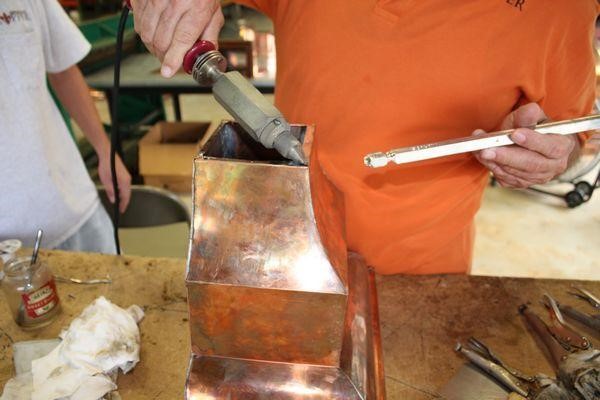In order to build high quality copper products such as kitchen hoods, awnings, louvers and charming decorative weathervanes, we first need sheets of copper.
Copper is one of the Earth’s basic chemical elements, in its purest form. It has a distinctive reddish-orange coloring that performs well with its high electrical and thermal conductivity.

Since it was first harvested, it is been used to make a variety of products including pots and pans, tubing, pipes, electrical wire, radiators etc. The essence of the metal is used as a preservative and pigment for a variety of products including wood, textiles, paint and paper. When combined with tin, it produces bronze, and with zinc, produces brass.
An Overview of What Happens
Copper in its purest form is very rare to find in nature. Typically, it is found in a combination with other chemicals that form copper ores. As a way to extract the copper, varieties of chemicals are used during processing to refine it to its purest form.
These minerals go through an extensive journey before they are ready to be placed on display in or on your home:
- Copper is mined from large deposits; the largest deposits are found in the United States and Chile.
- When the minerals are mined from the ground, it is in the form of a copper ore.
- These ores generally contain many other minerals and materials that must be removed through a grinding and smelting process.
- The material is heated in a large furnace in order to extract pure copper that can be used to manufacture products.
Concentrating
As a way to extract copper from the ore, the processing removes numerous non-copper bearing minerals, along with huge amounts of clay and dirt. After removing the waste material, the metal is concentrated using a slurry and flotation method. Once it is cleaning concentrated, it is put through a smelting process.
Smelting
Smelting is a process involving several chemical reactions that are used to remove sulfur and iron from the copper. Placed into a furnace, the copper concentrate mixes with a flux melt and collects at the bottom of the hot furnace. Most of the other metals including iron become highly concentrated forming a slag, which is removed by skimming it off the surface. The concentrated copper and other metals at the bottom of the furnace are referred to as matte, which goes through a second process called the converter, to purify it to over 99% copper by weight.
Refining
Even though it is pure by weight, the refining process is required to remove excessively high levels of oxygen and sulfur along with other impurities. The refining furnace uses air to help the molten metal oxidize its impurities. While still in its liquid form, electrical current is passed through the tank allowing the copper solution to become attracted to a cathode used to collect the metal, which is now rated at 99.95-99.99% pure copper.

Casting
After the blocks of copper cathodes are melted, the copper is cast into a variety of shapes including rods, billets, cakes and ingots. The next process uses a long series of rollers to form the bulk copper into thin sheets of metal and finally into the large copper rolls we use here at Crescent City Copper (link to home page) to build all of our products.
The impact of recycling
One factor that is quite encouraging about using copper for these products is that the materials do not necessarily need to come directly from the mine deposits anymore. Over half of all of the copper used today is made from recycled materials.
The quality is just as high, but these resources are much more sustainable and eco-friendly. Copper is one of the easiest to recycle minerals, and this process is become exceedingly favorable and popular.
Recycled copper comes from the recovery of old used recycled products that are smelted and cast into completely new materials that have all of the integrity of freshly mined copper, ready to last an indefinite number of generations to come. The recycling process is much more energy efficient and cost effective than extracting new core from the earth, and therefore enables businesses to reduce their carbon footprint while providing their customers with better prices.
Image Credit: WikiPedia
